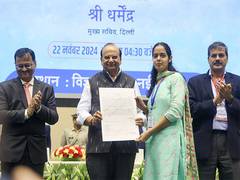Fourth runway, ECT becomes operational at Delhi airport
New Delhi, Jul 14 (PTI) The fourth runway and dual Eastern Cross Taxiways (ECT) became operational at the Delhi airport on Friday, a development that will increase the capacity and operational efficiency of the country’s largest airport, which is expected to have an annual passenger handling strength of 109 million in the near future.
Civil Aviation Minister Jyotiraditya Scindia on Friday inaugurated the fourth runway and ECT and said the country’s civil aviation sector is at an inflection point and the beginning of the growth phase.
Indira Gandhi International Airport (IGIA) is the first airport in the country to have four runways and ECT. It handles around 1,500 aircraft movements every day.
With the fourth runway and terminal expansion, which is expected to be completed soon, Scindia said Delhi airport’s passenger handling capacity will increase to 109 million per annum.
Currently, the capacity is 70 million passengers per year, he said and emphasised that Delhi airport will even beat Atlanta airport in its capabilities.
The fourth runway will result in the airport being able to handle more flights. It will increase the capacity throughput from the current level of 1,400 to 1,5000 aircraft movements to almost 2,000, Scindia said at the inauguration of the fourth runway and the ECT.
Air travel demand is on the rise and in June, domestic air passenger traffic rose nearly 19 per cent year-on-year to around 1.25 crore.
With the operationalisation of the ECT, taxiing time for planes will come down to around 10-12 minutes from around 20 minutes earlier, Scindia said.
Talking about the ECT, he also said that while planes will be taxiing on the ECT, vehicles will be moving on the road below.
Two wide-body planes like A380 and B 777 can use the ECT simultaneously, he added.
A ceremonial water cannon salute was accorded to an Air India plane to mark the operationalisation of the fourth runway. Flight AI 821 took off from Delhi to Srinagar.
IGIA is operated by the Delhi International Airport Ltd (DIAL), a consortium led by GMR Airports Infrastructure Ltd.
GMR Group Chairman GM Rao said the IGIA is the largest airport in India, serving around 70 million people annually. The fourth runway and the ECT will enable increased capacity and enhanced operational efficiency, he added.
IGIA has three terminals — T1, T2 and T3, and four runways — RW 09/27, RW 11R/29L, RW 10/28 and RW 11L/29R.
Last week, an official said that once the fourth runway is operational, the third runway — RW 11R/29L — will be closed for some time for maintenance work.
Scindia said the next challenge for the GMR Group is to ensure that the fourth terminal is operational by October, prior to the onset of the rush season.
“We are right now in consultations with airlines, Delhi airport, AAI to… create that international hub between T1, T2, T3 and T4 so that you have a seamless travel journey with minimum connect time between domestic and international travel. Thereby, regaining our pole position as an international hub, starting with Delhi and many more to come,” he said.
The ECT, which is 2.1 kilometres long and can accommodate wide-body aircraft, will reduce the time spent on the tarmac by passengers after landing and before take-off of their flights.
The ECT will connect the northern and southern airfields on the eastern side of the airport and will reduce the taxiing distance for an aircraft by seven kilometres. The distance an aircraft needs to cover after landing on the third runway and going to Terminal 1 (T1) will be reduced to two kilometres from 9 kilometres now.
The dual-lane ECT can handle wide-body aircraft, including A-380 and B-777 and B-747.
Each lane is 44 metres wide with a gap of 47 metres between them to allow simultaneous passage of two aircraft.
According to DIAL, the ECT is estimated to save around 350 kilograms of fuel every time an aircraft taxies through the runway from RW 29R to Terminal 1 and vice versa.
“This translates into a reduction of nearly 1,114 kg of CO2 emissions for each aircraft taxiing along this route. On an annual basis, the ECT is estimated to reduce emissions of approximately 55,000 tonnes of CO2 from aircraft,” it said last week.
Around 9,175 MT of fly ash has been used for the construction of the ECT.
Meanwhile, highlighting the growth of the country’s civil aviation sector in the last nine years, Scindia said the fleet capacity of domestic airlines increased to 720 planes from 400 planes, passenger handling capacity rose to 14.5 crore from 6 crore and the number of airports doubled to 148.
Scindia said now, the country has 148 airports, heliports and waterdromes and this will further increase to 220.
Air India and IndiGo have together placed orders for 970 planes.
“India is at an inflection point in the long history of civil aviation… this is the beginning of the growth phase in the Indian civil aviation space,” the minister said.
With plane orders from Air India, IndiGo and new airlines like Akasa Air expanding their capacities, the minister said there will be a time in India in the not-too-distant future that the fleet size will touch 1,500 planes.
Further, Scindia said the annual passenger handling capacity of airports is expected to rise to nearly 42 crore by 2030 from the current level of 14.5 crore.








